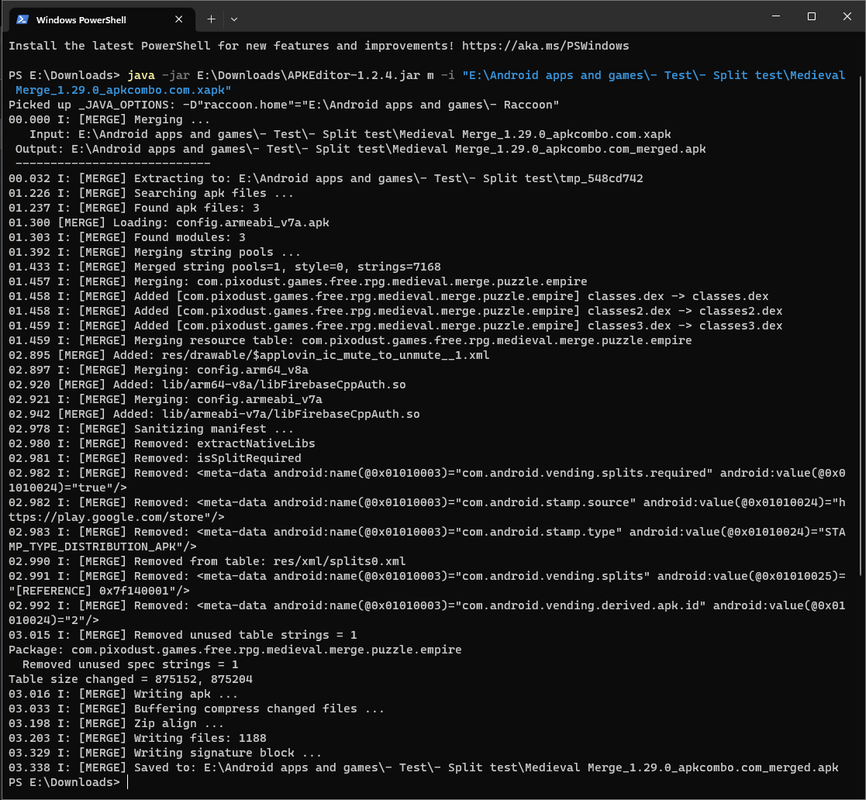Understanding APK File Structure
How to Merge APK Files into a Single Package are the center design for Android apps. They contain the code, resources, and resources required for an application to work on a gadget. At times, clients need to merge multiple APK documents into one package, especially if they’re managing split APKs. Split APKs are multiple APK records made to make application circulation more adaptable by splitting resources into various documents. Merging these into one can work on the installation and the executives.
Before plunging into the method involved with merging APKs, it’s fundamental to comprehend the design of an APK document. An APK is a zipped document containing a few parts:
This record gives fundamental data about the application, similar to consents, and application adaptation, and that’s just the beginning.
- This is the arranged Java code that runs the application.
- Pictures, sound records, and different resources that the application utilizes.
- Local libraries in paired structures are important for the application’s working.
- This envelope contains metadata and mark data.
At the point when you need to merge APK records, particularly split APKs, you’re managing documents like base APKs and other asset APKs.
In this article, we will cover the most common way of merging APK records into a solitary package. We’ll separate the means, the devices required, and the likely dangers to consider. Merging APKs can be interesting, yet with the right information, it becomes simpler.
More Queries: How to Test APK Files on an Emulator
Best Practices for Merging APK Files:
To ensure a smooth merging process, consider the following best practices:
- Before you begin merging, consistently make duplicates of the first APKs.
- When the APK is merged, test it on multiple gadgets to ensure similarity.
- Ensure you’re utilizing dependable instruments like APKTool and ADB for the best outcomes.
- Knowing the inside structure of APKs will assist you with settling clashes and issues rapidly.

Steps to Merging APK Files
Now that we understand the structure and have the tools ready, let’s look at the steps involved in merging APK files.
Extract APK Files:
First, you’ll have to extricate the items in each APK record that you wish to merge. You can involve APKTool for this. Open an order brief or terminal and run the accompanying order:
1: apktool d base.apk
2: apktool d split_config.en.apk
3: apktool d split_config.xxhdpi.apk
This order will decompile the APK documents into indexes. You’ll currently see organizers containing the separated items in each APK.
Combine Resource Files:
The following stage is to merge the asset documents. Go into the res envelope of each APK, and you will see subfolders like drawable, format, and values. You’ll have to physically merge these documents. Ensure that there are no struggles between the records. If two records have a similar name but unique substance, you’ll have to pick which one to keep.
For instance, duplicate the items in the drawable organizer from the split APK into the drawable envelope of the base APK. Do likewise for different organizers.
Modify the AndroidManifest.xml:
The AndroidManifest.xml document contains significant data about the application. Since you’re merging APKs, you want to refresh the manifest to mirror this change. Open the AndroidManifest.xml document from the base APK and the other APKs. Check for any extra consents, exercises, or administrations pronounced in the split APK shows that are absent in the base APK manifest. Add these announcements to the base APK manifest.
Ensure that the merged manifest document has every one of the important parts from both APKs. On the off chance that there are copy sections, you’ll have to determine them to stay away from blunders.
Recompile the APK:
Whenever you’ve merged the asset records and refreshed the manifest, it’s an opportunity to recompile the APK. Use APKTool to recompile the APK:
apktool b base
This order will modify the APK from the merged documents. The result will be another APK document, however it isn’t yet marked.
Step 5: Sign the APK
Each APK record should be endorsed before it is installed on an Android gadget. To sign the APK, you can utilize the jarsigner apparatus that accompanies the Java Improvement Pack (JDK). Run the accompanying order:
jarsigner -verbose -sigalg SHA1withRSA -digestalg SHA1 -keystore my-release-key.keystore base/dist/base.apk alias_name
Replace my-release-key.keystore with the path to your keystore file, and alias_name with your keystore alias.
Once the APK is signed, it is ready for installation.
Test the Merged APK:
The final step is to test the APK on an Android device to ensure that it works correctly. Use ADB to install the APK:
adb install base/dist/base.apk
Check if the app runs smoothly and all the resources from the split APKs are correctly merged.
Risks and Challenges in Merging APKs:
While merging APK records can work on things, there are a few difficulties and dangers to know about:
- If two APKs have various adaptations of a similar asset (like pictures or formats), it very well may be hard to choose which one to keep.
- Erroneously altering the manifest document can prompt crashes or glitches in the application.
- On the off chance that the APK isn’t marked accurately, it will not install on Android gadgets.
- The merged APK probably won’t be viable with all Android gadgets, particularly on the off chance that there are issues with the split APK arrangements.
Tools Needed for Merging APK Files:
To merge APK documents, you will require explicit apparatuses. These apparatuses assist with dealing with the records, separating substances, and repackaging the APKs after merging. The following are the most usually utilized apparatuses:
- This instrument is broadly utilized for decompiling and recompiling APK documents. It permits you to extricate and alter the substance inside the APKs.
- This is expected for working with APKs and aggregating documents.
- Since APKs are compressed documents at their center, you’ll require an instrument to unfasten and rezip the records.
- Albeit not straightforwardly connected with merging, ADB assists you with testing the APK on a gadget.
Ensure these apparatuses are appropriately installed on your framework before proceeding

Why Merge APK Files?
There are a few motivations behind why you should merge APK records into a solitary package. These include:
- Instead of having multiple APK records, having one APK makes installation faster and more straightforward.
- A few gadgets may not deal with split APK installations appropriately.
- A solitary APK record is simpler to move between gadgets or offer with others.
Nonetheless, the cycle isn’t without gambles. Merging can prompt similarity issues, likely debasement of records, and difficulties during the installation. Consequently, it’s fundamental to painstakingly follow the cycle.
Conclusion
How to Merge APK Files into a Single Package Download can make applications the executives more clear. With the right devices and cautious tender loving care, the cycle turns out to be a lot simpler. Be that as it may, merging APKs accompanies gambles, including asset clashes, manifest issues, and marking issues. Following the means illustrated in this aide and sticking to best practices will assist you with keeping away from these entanglements.
By consolidating APKs into one record, you oversee application installations, making it more straightforward to disperse and install apps on various gadgets. Make sure to test your last APK completely before conveying it.




